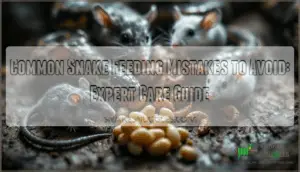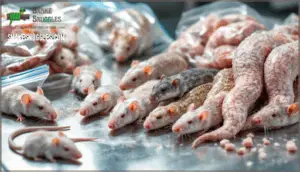This site is supported by our readers. We may earn a commission, at no cost to you, if you purchase through links.

Proper feeding practices require understanding species-specific dietary needs, establishing consistent routines, and recognizing early warning signs of nutritional problems. Getting the fundamentals right—from prey selection to feeding frequency—prevents obesity, metabolic disorders, and behavioral stress that can take months or years to reverse.
Table Of Contents
- Key Takeaways
- Common Snake Feeding Mistakes to Avoid
- Choosing The Right Prey for Your Snake
- Establishing an Effective Feeding Routine
- Monitoring Snake Health and Nutrition
- Best Practices for Snake Care and Hydration
- Frequently Asked Questions (FAQs)
- Do snakes eat pre-killed prey?
- Should you feed a snake in a separate container?
- How do I know if my snake is eating too much?
- What happens if you feed a snake too often?
- Can pet snakes eat live prey?
- Can pet snakes eat frozen prey?
- How do I properly feed my snake?
- What food is bad for snakes?
- What to do if your snake won’t eat?
- Is it bad to feed your snake too much?
- Conclusion
Key Takeaways
- Overfeeding and underfeeding both cause serious harm—obesity damages organs and shortens lifespan, while underfeeding stunts growth and triggers nutritional deficiencies that can take months to reverse.
- Prey size must match your snake’s body diameter at its thickest point to prevent regurgitation, impaction, and choking, with different guidelines for hatchlings, juveniles, and adults.
- Establishing consistent feeding schedules based on your snake’s age and species (hatchlings every 5-7 days, adults every 7-30 days depending on type) prevents metabolic disruption and stress-related health problems.
- Regular monitoring through feeding logs, weight tracking, and body condition checks lets you catch health issues early, and consulting a reptile specialist is essential if your snake refuses food beyond four weeks or loses over 10% body weight monthly.
Common Snake Feeding Mistakes to Avoid
Feeding your snake properly isn’t just about tossing in prey and calling it a day. Even experienced keepers can fall into habits that compromise their snake’s health, from offering the wrong prey size to overlooking basic hygiene.
Let’s walk through the most common feeding mistakes so you can avoid them and keep your snake thriving.
Overfeeding and Its Health Risks
When you overfeed your snake, you’re setting the stage for serious health complications. Obesity in snakes leads to organ damage, metabolic disorders, and a reduced lifespan, as excess fat accumulates around essential organs and impairs their function. Overfeeding also increases regurgitation risks, disrupting your snake’s digestive system and overall well-being.
Overfeeding your snake causes obesity, organ damage, and reduced lifespan as excess fat accumulates around vital organs and impairs their function
Maintaining a balanced snake diet with proper feeding intervals protects snake health and prevents these preventable conditions. Overfeeding can lead to snake liver disease, a common issue in obese snakes.
Underfeeding and Nutritional Deficiencies
On the flip side, underfeeding your snake triggers equally severe problems. When feeding intervals stretch too long or meal sizes remain too small, you risk stunted growth, dangerous weight loss, and chronic nutritional deficiencies. Juvenile snakes lose over 20% of their body mass after six months without adequate food, while metabolic rate drops dramatically to compensate for energy shortages.
Watch for these warning signs of underfeeding:
- Visible spine or ribs indicating poor body condition and fat depletion
- Delayed shedding cycles from insufficient energy reserves
- Lethargy and muscle weakness suggesting ongoing nutritional stress
- Neurological symptoms like tremors from thiamine deficiency in fish-eating species
Your snake’s dietary needs change as it matures. Hatchlings need feeding every 5-7 days, while adults thrive on 20-30 day intervals. Tracking weight and adjusting feeding schedules prevents nutritional disorders and growth effects that compromise snake health long-term. In severe cases, this can even lead to starvation and debilitation.
Inadequate Prey Size or Type
Getting prey size right matters just as much as feeding frequency—offer rodents that are too large, and your snake risks regurgitation, impaction, or even fatal choking. Prey should measure roughly the same width as your snake’s body at its thickest point, preventing digestive issues and injury risk.
Wrong prey type causes nutritional imbalance too—corn snakes thrive on mice, while kingsnakes need dietary variety including lizards. Prey rejection often signals mismatched dietary needs.
Ignoring Feeding Schedules
Skipping meals or feeding haphazardly throws off your snake’s metabolism and can trigger stress-related health problems that range from weakened immunity to outright refusal to eat. Consistent feeding schedules support proper digestion and align with your snake’s natural biorhythm, preventing metabolic disruption.
Consider these species-based intervals:
- Juvenile snakes: every 5-7 days
- Adult colubrids: every 7-14 days
- Adult boas/pythons: every 14-21 days
- Elderly snakes: every 21-30 days
Irregular snake feeding creates long-term effects on reptile care outcomes and overall snake health.
Poor Hygiene During Feeding
When you neglect cleaning protocols around feeding time, you’re basically rolling out a welcome mat for bacterial contamination, mold growth, and parasitic transmission that can compromise your snake’s immune system.
Caretaker hygiene directly affects snake health, so wash your hands before and after touching prey or your reptile.
Water sanitation and enclosure cleaning prevent health problems from pests and bacteria risk while supporting effective parasite prevention.
Choosing The Right Prey for Your Snake
Selecting appropriate prey isn’t just about what your snake will eat—it’s about what keeps them healthy long-term. The right choice depends on your snake’s species, size, and natural feeding behavior.
Let’s look at the key factors that’ll help you make informed decisions about your snake’s diet.
Species-Specific Dietary Needs
You can’t apply a one-size-fits-all approach to snake nutrition—each species evolved with distinct dietary specialization shaped by millions of years of ecological adaptation. Over half of higher snakes consume lizards as a primary food source, while others specialize in mammals, amphibians, fish, or even other snakes, and these prey diversity patterns directly determine your snake’s nutritional requirements in captivity.
Wild diets can’t be perfectly replicated, but understanding your snake species’ natural prey preferences helps you select appropriate captive diets that meet species-specific dietary needs and prevent serious deficiencies.
Prey Size Relative to Snake Size
Choosing prey that matches your snake’s body diameter prevents regurgitation, impaction, and feeding-related injuries that compromise long-term health. Best prey size should never exceed the snake’s widest body point, usually at mid-body, to avoid choking hazards and regurgitation risks that stress your snake’s digestive system.
Follow these size guidelines:
- Hatchlings: Prey should be approximately the same width as the snake’s head
- Juveniles: Prey width matches the snake’s thickest body section
- Adults: Prey slightly smaller than maximum girth promotes healthy digestion
Appropriate prey size directly affects growth impact and prevents serious digestive issues throughout your snake’s life.
Whole Prey Vs. Processed Foods
Whole prey offers greater nutritional value compared to processed snake foods, providing essential nutrients through bones, organs, and muscle tissue that commercial alternatives can’t fully replicate. Nutrient bioavailability from whole prey surpasses processed options, supporting digestion efficiency and long-term health.
| Whole Prey | Processed Foods |
|---|---|
| Complete nutrition with natural prey size variety | May lack essential vitamins and minerals |
| Promotes natural feeding behavior and digestion efficiency | Convenient but potentially incomplete snake nutrition |
| Better ethical considerations and cost analysis over time | Higher per-feeding cost with limited snake diet benefits |
Assessing Prey Quality and Safety
The quality of your snake’s prey can mean the difference between a thriving reptile and one battling preventable parasites or nutritional shortfalls.
Source rodents from reputable suppliers who follow ethical sourcing practices and maintain proper sanitation standards.
When thawing frozen prey, never use microwaves or hot water, as bacterial contamination multiplies rapidly at incorrect temperatures.
Inspect each prey item for signs of decay or injury before offering it to your snake, and avoid live prey whenever possible to minimize parasite risks.
Establishing an Effective Feeding Routine
Getting your feeding routine right isn’t just about what you feed—it’s about when, how, and how often. Your snake’s age and species determine its nutritional needs, and consistency prevents health problems down the road.
Let’s break down the key elements that’ll help you establish a feeding schedule your snake will thrive on.
Age and Species-Based Feeding Frequency
Your snake’s age and species determine how often it needs to eat—juvenile pythons may require weekly meals while adult corn snakes thrive on bi-weekly feedings. Hatchling feeding schedules differ greatly from adult frequency, as young snakes grow rapidly and demand more consistent nutrition.
Species variation plays an important role, since metabolic rates vary widely. You’ll need to adjust dietary needs during breeding considerations, when females require extra energy to produce healthy offspring.
Benefits of a Feeding Log
Keeping track of what, when, and how much your snake eats isn’t just good record-keeping—it’s a diagnostic tool that helps you spot health issues before they become serious problems.
Dietary intake tracking allows you to recognize health patterns, improve feeding schedules, and prevent nutritional deficiencies.
When you consult a reptile specialist, your feeding log becomes invaluable evidence, documenting your snake’s diet and nutrition history to support accurate diagnosis and care recommendations.
Safe Feeding Techniques
How you present food to your snake matters just as much as what’s on the menu—poor technique can turn mealtime into a stressful ordeal or even put you at risk of a defensive bite.
Use feeding tools like long tongs to present frozen-thawed prey, which eliminates live prey risks such as injury to your snake.
Properly offering prey reduces regurgitation—let your snake strike naturally, then leave it undisturbed to swallow. These safety measures make feeding routine rather than risky.
Creating a Stress-Free Feeding Environment
Even with perfect feeding technique, your snake won’t eat comfortably if the surrounding environment feels chaotic or threatening. Create a quiet feeding space with dim lighting to minimize stress and encourage natural feeding behavior. A gradual approach helps you observe behavior without overwhelming your snake.
Key environmental factors:
- Keep the snake enclosure in a low-traffic area away from loud noises or sudden movements.
- Avoid picking up for 24-48 hours before feeding to reduce defensive responses.
- Maintain stable environmental conditions, including temperature and humidity, during feeding times.
- Watch for signs of stress like defensive posturing, and adjust your approach accordingly.
Monitoring Snake Health and Nutrition
Keeping your snake healthy means watching for signs that its diet is working. You’ll need to track changes in weight, feeding behavior, and overall condition to catch problems early.
Let’s look at the key indicators that tell you whether your snake’s nutrition is on track.
Recognizing Signs of a Healthy Diet
Well-fed snakes show clear body condition markers you can spot during routine checks. Look for a 4-out-of-5 body condition score with visible muscle tone and ribs only during movement.
Consistent shedding patterns every 4–8 weeks signal proper hydration and metabolism, while glossy scales reflect adequate vitamins.
Strong immune function means fewer infections, and healthy digestive health shows up in predictable behavior patterns—alert activity resuming within 24–72 hours post-feeding.
Tracking Weight and Appetite Changes
Monitoring your snake’s weight monthly with a digital scale catches problems before they snowball into serious health issues. Sudden weight fluctuation analysis reveals obesity risks or appetite loss causes like parasites, while tracking body condition during shedding helps you separate normal feeding pauses from concerning behavior correlation patterns that signal stress or illness requiring intervention.
Adjusting Diet Based on Health Indicators
When health indicators shift—whether it’s a dull shed, sluggish behavior, or changes in body condition—fine-tuning your snake’s diet becomes the most direct path to restoring balance and preventing long-term complications. Adjust based on these observations:
- Weight fluctuations and activity levels may signal overfeeding or nutritional deficiencies
- Shedding issues often respond to increased humidity and supplement needs
- Fecal analysis reveals parasites causing anorexia or dietary-related diseases
- Persistent snake health problems require prey size adjustments or dietary diversity
When to Consult a Reptile Specialist
Although routine check-ups remain underutilized by 58% of snake owners, recognizing emergency signs can be lifesaving. Consult a reptile specialist immediately if you observe refusal to eat beyond four weeks, weight loss exceeding 10% monthly, regurgitation with blood, fungal disease symptoms, or neurological issues.
Specialist exams, including bloodwork and fecal testing, address snake health problems like anorexia and parasitic infections that threaten proper snake diet and nutrition.
Best Practices for Snake Care and Hydration
Proper hydration and environmental care form the foundation of your snake’s overall health, working hand-in-hand with a solid feeding routine. Beyond nutrition, you’ll need to address water quality, humidity control, habitat setup, and interaction methods.
Let’s walk through the essential practices that keep your snake thriving between meals.
Providing Clean, Fresh Water
You wouldn’t leave yourself without water for days, so your snake deserves the same fundamental respect with regard to hydration. Proper water source type and bowl size directly impact your snake’s health and care, supporting everything from daily hydration to shedding assistance. Here’s what you need to know:
- Choose a heavy ceramic crock that can’t be easily tipped over
- Make sure the water bowl is large enough for your snake to soak in comfortably
- Change water daily to prevent bacteria growth and maintain vitamin and water requirements
- Monitor for contamination since snakes often eliminate in their water, requiring immediate cleaning
Maintaining Proper Humidity Levels
Think of humidity as your snake’s invisible wellness blanket—too little leaves them struggling through sheds with stuck skin, while just the right amount keeps their respiratory system healthy and their scales supple.
Most snakes thrive between 40-60% humidity, though species vary, so research your specific snake’s needs. Check levels daily using a reliable hygrometer, and adjust through enclosure setup modifications like substrate moisture or ventilation changes.
Proper environmental conditions prevent shedding difficulties, respiratory infections, and dehydration while supporting overall hydration and feeding success.
Environmental Enrichment for Feeding
Creating a stimulating feeding environment isn’t just about dropping prey into an enclosure—it’s about mimicking natural hunting behaviors that keep your snake mentally sharp and physically engaged.
Use scent enrichment, varied presentation methods, and naturalistic setups to activate hunting instincts. While puzzle feeders and strategic prey placement improve engagement, they complement—not replace—species-appropriate environmental conditions that support healthy feeding responses.
Safe Handling Before and After Feeding
Once your snake’s engaged in natural feeding behaviors, knowing how to interact with them safely around mealtimes protects both of you from stress and potential injury.
Pre-feeding prep means minimal interaction to prevent defensive strikes, while post-meal interaction should wait 24-48 hours to reduce regurgitation risk.
Safe snake restraint techniques and calm environmental conditions minimize feeding-related aggression, protecting you from bites and injuries while supporting proper digestion.
Frequently Asked Questions (FAQs)
Do snakes eat pre-killed prey?
Most captive snakes readily accept pre-killed prey, which offers significant safety benefits for both you and your snake.
Frozen rodents, properly thawed, provide excellent nutritional value while eliminating injury risks from live prey.
Should you feed a snake in a separate container?
Feeding your snake in its regular enclosure is generally recommended, as moving it to a separate container can increase stress and manipulation risks.
This practice stems from outdated concerns about substrate ingestion, but proper feeding techniques within the snake enclosure eliminate this issue while promoting better snake behavior and safety.
How do I know if my snake is eating too much?
Visible weight gain around the midsection, decreased activity, and irregular shedding patterns signal potential overfeeding.
Monitor body condition closely, as obesity predisposes snakes to regurgitation risks and dietary-related diseases that compromise long-term health.
What happens if you feed a snake too often?
Overfeeding triggers obesity risks, organ damage, and metabolic disorders in snakes. You’ll notice regurgitation issues, digestive complications, and reduced lifespan when feeding frequency exceeds species-specific needs, leading to serious dietary-related diseases.
Can pet snakes eat live prey?
Yes, pet snakes can consume live prey, but this practice carries significant risks. Live prey can inflict bites and defensive injuries on your snake, potentially causing infections or trauma.
Pre-killed or frozen-thawed options eliminate these safety concerns while providing complete nutritional value.
Can pet snakes eat frozen prey?
Wondering whether freezing diminishes nutritional value? Frozen-thawed prey items are excellent for feeding your snake, offering the same dietary needs fulfillment as live prey.
Thawing safely prevents refreezing risks, and proper prey storage maintains quality while gut loading promotes nutrition.
How do I properly feed my snake?
Start by recognizing hunger cues—your snake becomes active, explores, and flicks its tongue frequently.
Proper prey preparation involves thawing frozen rodents completely, offering appropriately-sized items, and maintaining consistent feeding frequency based on your snake’s age and species.
What food is bad for snakes?
Toxic prey, spoiled food, and unsafe rodents harbor harmful bacteria or intestinal parasites that can compromise your snake’s health. Wild-caught prey may introduce parasites, while wrong supplements cause nutritional deficiencies.
Always guarantee fresh, appropriately sized whole prey items that meet your snake’s species-specific dietary needs.
What to do if your snake won’t eat?
When your snake stops eating, environmental factors like temperature drops or inadequate humidity often trigger feeding refusals. Stress reduction—minimizing interaction and loud noises—helps restore appetite.
Check if your snake’s shedding cycle coincides with reluctance, as snakes naturally fast before shedding.
Underlying illnesses require veterinary intervention to rule out parasites or infections affecting dietary needs.
Is it bad to feed your snake too much?
Overfeeding your snake causes serious health problems. Excess food leads to obesity, organ damage, and a dramatically reduced lifespan. Your snake may also experience regurgitation issues and develop fatty liver disease.
Follow species-appropriate feeding schedules to prevent these complications.
Conclusion
The old adage "an ounce of prevention is worth a pound of cure" rings especially true when managing common snake feeding mistakes to avoid. A single miscalculation—wrong prey size, inconsistent schedules, or poor sanitation—can trigger cascading health problems that take months to resolve.
By mastering the fundamentals of species-specific diets, establishing predictable feeding routines, and monitoring your snake’s body condition regularly, you’re investing in decades of vitality rather than years of costly corrections. Your snake’s wellbeing depends on these deliberate choices.
- https://news.uark.edu/articles/10141/how-snakes-survive-starvation
- https://www.reddit.com/r/ballpython/comments/1g3a57q/underweight_considering_5_or_6_day_feeding/
- https://pmc.ncbi.nlm.nih.gov/articles/PMC6420799/
- https://www.msdvetmanual.com/exotic-and-laboratory-animals/reptiles/nutritional-metabolic-and-endocrine-diseases-of-reptiles
- https://www.dvm360.com/view/introduction-reptile-medicine-proceedings













